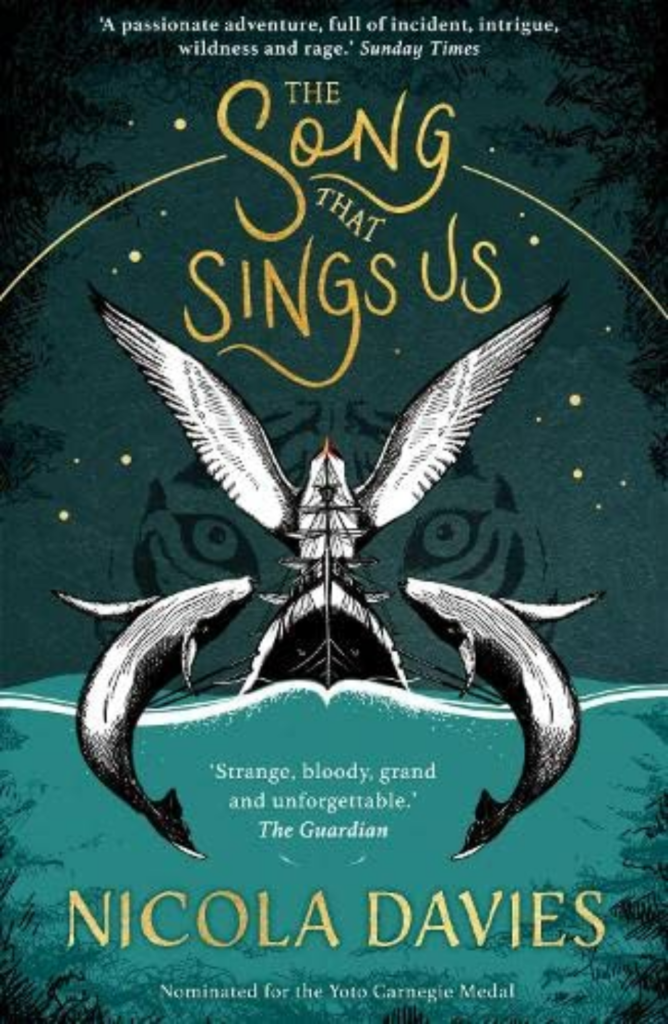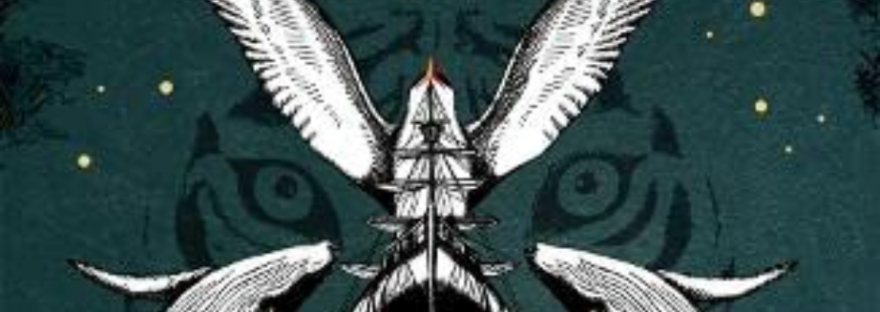By Nicola Davies (published by Firefly Press)
The sounds of hard breathing and the scrunch of footfalls enclose them as they run. There are shouts behind, voices yelling orders, more shots. Harlon gives Xeno and Ash a stream of small orders and encouragements to stop them thinking.
In Harlon’s head, her ma’s voice speaks.
When you are in danger, the most dangerous thing is to wish you weren’t. Accept the reality of danger, then you can survive it.
Climb, she tells herself. Get away.
Harlon has been raised to protect her younger siblings, who were born ‘Listeners’ – humans with the ability to communicate with animals, an ability that is outlawed and touted as dangerous by the Automators. But when Automators attack their home, the siblings are separated, and simply left with a promise made to their mother: that they would reach “an island lost in the deepest part of the ocean”.
So begins an epic journey for the three children, attempting to find the island and each other, all while being hunted by the sinister ‘Commander Eye’ Doada and his Automators. Along the way, they’ll find new friends and make unexpected allies, as they journey to keep their song alive.

The Song That Sings Us is a tale of the importance of nature, and the damage that humans can cause with greed, selfishness, and arrogance. Its message is very clear and it places it front and centre, like a cross between some kind of technological-dystopia and an eco-fable.
The Automators are using technology to rid themselves and humankind of the “tyranny of nature”; replacing “lectric veekles” with tar-fuelled “karz”, chopping down forests, and razing small villages to move people into large cities. The scattering of English-like words lends to the dystopian feel, as if the story is set in a future where capitalism is fighting back after a golden age of nature and harmony. If this is the intention, then it’s no accident that the map (which is wonderful by the way, I’m a big fan!) bears a more-than-passing resemblance to Wales, or that the land of Rumyc is an anagram of Cymru.
The first chapter kicks off with the attack, giving us no opportunity to get attached to the children’s previous life. In some stories this might be a flaw, but not so here. The action is frenetic and stressful, giving neither the characters nor the reader time to rest and contemplate, and when we do get a quiet moment, the thoughts of the characters are enough to give us a sense of what was lost. These quiet moments don’t last long though!
The story switches its point-of-view character between chapters, taking us from the children or flashbacks of their mother’s history, to the leader of the Automators Doada, and even a couple of the animals early in the story. The plot is constantly moving, meaning a large cast of characters, but the situations differ enough that it’s not hard to keep track of them.
Harlon’s story is the one we come back to the most, and she is every bit her mother’s daughter, smart and brave. Unlike her siblings, she is not a Listener, which means the story feels well-balanced between them. Rather, her strength lies in her training and resilience; she is always thinking ahead, using the mantra “Assess, Think, Act” taught to her by her mother. I was pleased that this was more than a throwaway line, and that she repeats it throughout the book.
Ash and Xeno are a few years younger, used to being provided for and protected. At the start of the action, Ash is scared and withdrawn, and it takes him some time to stand up for himself. Like Harlon, Ash has a good heart, but without the stern edge from years of training. As the story progresses, he grows and matures, and he has a way of drawing people to him and making friends that benefits the group later on.
Xeno is the oddest of the three. Although the same age as Ash, she communicates in riddles and bird song – her power is so strong that she essentially can’t turn it off, leaving her brain a bit addled. This gives her a slightly creepy, almost ethereal quality at times, especially when being questioned by Commander Eye (the scene where she leaves him unnerved may be one of my favourite moments!).
Initially I was a bit disappointed that we didn’t learn much about their mum, so it was great to come across the flashback chapters. They do a fantastic job of showing us the family’s history in a way that doesn’t feel like a third person giving clunky exposition. You get the feeling that motherhood doesn’t come naturally to her, and some of the decisions you see her make in the past you may not agree with. Although their mother is barely in the book except flashbacks, she is a constant presence for the children, and especially Doada.
I found it interesting to read the chapters focused on Doada – it’s unusual that you get a villain’s point-of-view, let alone several times throughout the story. It means the reader isn’t left second-guessing his plans, and I found this very useful for upping the tension throughout, as each of the children gets glimpses into the evil we already know he’s plotting.
I will refrain from talking about the animals that you meet throughout the story, as I think it is better to experience them blind, allowing your feelings for them to develop naturally, like the children’s do. Don’t go into this thinking that they will be minor or throwaway however; they are just important as the humans!
You can absolutely see the care that Davies has for the subject, and her research and experience definitely pays off; the sheer level of detail with regards to nature, different species, ecosystems, and more gives the story a layer of realism that otherwise could feel very superficial.
I will say that it’s not a gentle book. The bad guys are bad, and their actions are grim. The Automators are greed and capitalism cranked up to eleven, or perhaps just more openly so. Not everyone makes it through the story, and when we do lose characters, it is swift and brutal – there are no long, drawn out descriptions, just simple facts that contrast with the empathy we have developed for them. The cavalier approach the Automators have to life echoes how easily living beings, especially animals, can be poorly treated in our own world.
As a result, I would say this is a book for slightly older readers – Ash and Xeno are 12, and I think that’s probably a good age, on the cusp between middle grade and young adult. Not only are there some darker moments (as mentioned above), but the book is roughly 400 pages – fine for some KS2 readers, but not all.
The Song That Sings Us is a complex tale with a strong sense of heart and justice. It’s not just above caring for the planet but those on it too, whether they move on no legs, four legs, or two. The pace barely lets up, so it’s a good choice not only for those interested in environmental issues but those who enjoy fantasy-action.
If you’d like to follow the song to the lost island, you can grab a copy at the link below.
(Disclosure: If you buy books linked to our site, we may earn a commission from Bookshop.org, whose fees support independent bookshops.)
Looking for more books about current issues? If so, you can see our previous reviews here.

